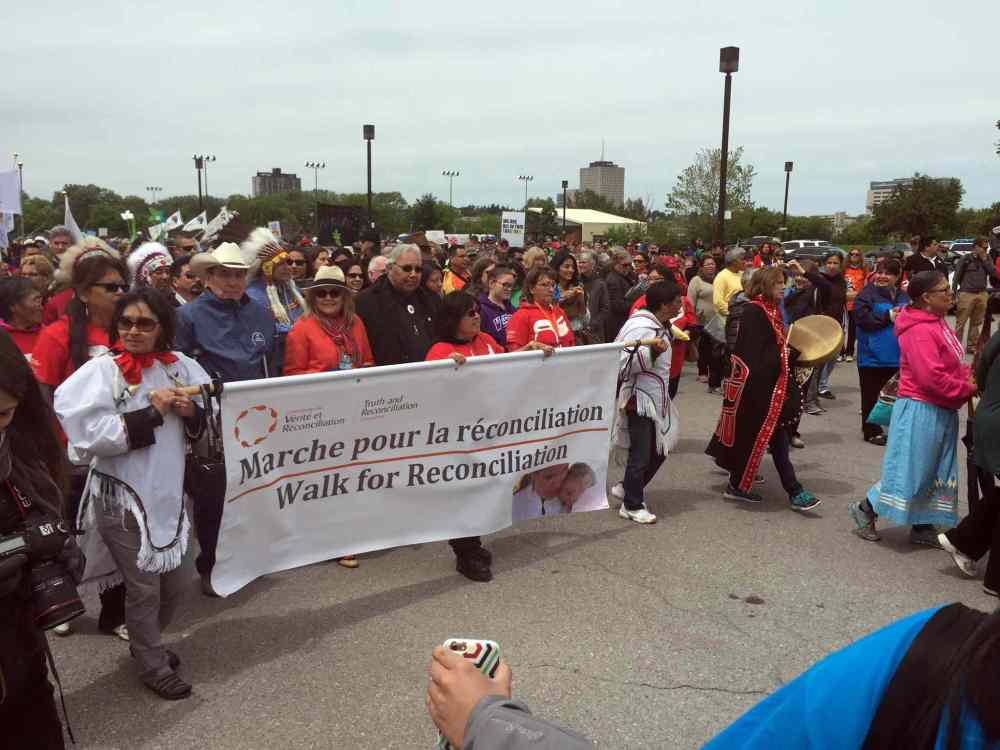Large crowd gathers for Walk for Reconciliation in Ottawa
Advertisement
Read this article for free:
or
Already have an account? Log in here »
To continue reading, please subscribe:
Monthly Digital Subscription
$0 for the first 4 weeks*
- Enjoy unlimited reading on winnipegfreepress.com
- Read the E-Edition, our digital replica newspaper
- Access News Break, our award-winning app
- Play interactive puzzles
*No charge for 4 weeks then price increases to the regular rate of $19.00 plus GST every four weeks. Offer available to new and qualified returning subscribers only. Cancel any time.
Monthly Digital Subscription
$4.75/week*
- Enjoy unlimited reading on winnipegfreepress.com
- Read the E-Edition, our digital replica newspaper
- Access News Break, our award-winning app
- Play interactive puzzles
*Billed as $19 plus GST every four weeks. Cancel any time.
To continue reading, please subscribe:
Add Free Press access to your Brandon Sun subscription for only an additional
$1 for the first 4 weeks*
*Your next subscription payment will increase by $1.00 and you will be charged $16.99 plus GST for four weeks. After four weeks, your payment will increase to $23.99 plus GST every four weeks.
Read unlimited articles for free today:
or
Already have an account? Log in here »
Hey there, time traveller!
This article was published 31/05/2015 (3822 days ago), so information in it may no longer be current.
OTTAWA – More than 10,000 people from all walks of Canadian life walked side by side in a symbolic show of reconciliation for the atrocities committed in residential schools Sunday.
The Walk for Reconciliation kicked off four days of closing events for the Truth and Reconciliation Commission. It was tasked by the Indian Residential Schools Settlement Agreement in 2007 with laying bare the facts about what happened at the schools and setting in place the groundwork for resolving the hangovers of that dark period in Canadian history.
“Never forget this day,” said TRC Chair and Manitoba Justice Murray Sinclair, to the crowd at the walk’s conclusion on a plaza outside Ottawa City Hall. “This is the day we begin to change the history of this country.”

The Walk for Reconciliation began at a high school in Gatineau, Que., south across the Ottawa River, stopping briefly at Victoria Island before continuing on past Parliament Hill and ending at Ottawa City Hall.
As the walkers made their way past the Supreme Court of Canada – which made news last week when Chief Justice Beverley McLachlin said the residential schools were a cultural genocide – the bells of a nearby church rang out.
Other churches across Canada rang their bells simultaneously, all in an effort to draw Canadians attention to the matter at hand.
That is to bring to a conclusion the six-year mandate of the TRC but more importantly to pay attention to what the survivors have told the TRC commissioners happened, and what needs to happen to bring to some resolution the relationship between Canada and the Indigenous people.
“Reconciliation is not an aboriginal problem,” said Sinclair. “It is a Canadian problem.”
Ontario Premier Kathleen Wynne was the only premier to participate Sunday and she added her voice to those who refer to residential schools as a “cultural genocide.”
Olympian Clara Hughes was selected as an honorary witness and called on Canadians to learn from the TRC and make a pledge that “the real dark history of our country, that most of us aren’t taught in school, that we never forget it and we never ever let it happen to anybody on this soil ever again.”
The atmosphere around the walk was generally one of optimism and warmth. Aboriginal Affairs Minister Bernard Valcourt was there and said the government was committed to “resolving the legacy of residential schools in Canada.”
However the government’s actions since it apologized for residential schools in 2008 have left many survivors and aboriginal leaders feeling the words were empty.
Sinclair himself told the Free Press last week he didn’t expect much from the government on the TRC report.
More than 150,000 First Nations, Metis and Inuit children were scooped up from their homes and forced to attend residential schools where they were forbidden from speaking their languages and taught their culture was inferior. Thousands of students also have come forward to tell stories of physical, psychological and sexual abuse.
Sinclair said Sunday there is no denying the schools were an effort to force assimilation on aboriginal children.
Their legacy has been blamed for many of the problems facing Indigenous people in Canada today.
mia.rabson@freepress.mb.ca
History
Updated on Sunday, May 31, 2015 2:50 PM CDT: Wriethru.
Updated on Sunday, May 31, 2015 3:24 PM CDT: Updates crowd numbers in cutline.


